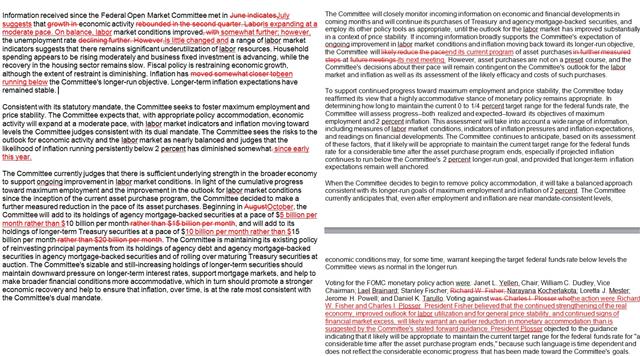FOMC triggers USA trifecta in USD, stocks & yields
A rallying trifecta in the US dollar, equity indices and bond yields emerged after the FOMC issued slightly more hawkish projections on the Fed Funds rate. 14 of the 16 Fed members expect a rate hike in 2015 but, more importantly, the median estimate for the Fed Funds rate by end of 2015 is now 1.375% from 1.0% in the June projections.
The FOMC statement on jobs added that “labour market conditions improved somewhat further”, but described the unemployment rate as “little changed” from “declining further”.
On inflation, the FOMC sounded a bit more dovish, stating inflation has “been running below the Committee's longer-term objective” rather than “moved somewhat closer to the Committee's longer-term objective”.
On tapering, the Committee confirmed it “will end its current program of asset purchases at its next meeting” from the prior meeting's indication that it “will likely reduce the pace of asset purchases at future meetings”.
Dallas Fed's Fisher joined Philly Fed's Plosser in dissenting against the use of “considerable time” phrase, with wanting to move earlier than stated in the guidance. The US dollar soared across the board, over 120 pips against the euro. 10-year yields pushed up to 2.62% from 2.57% and the S&P 500 jumped towards its intraday high of 2011 before retreating and ending up 2 pts.
Kiwi damage shadows franc & yen selloff
USD/CHF regained the 0.9400 for the first time in 12 months as the franc took a beating across the board on the realisation that Thursday's meeting at the Swiss National Bank will reiterate the threat to: intervene in FX markets; remain on easing alert into subsequent meetings; and issue lower forecasts for inflation.
While the yen plummeted on the initial rally in equities, a late session stabilisation emerged as stocks pared their gains. But it was the New Zealand dollar, which dominated losses after NZ economists earlier cut their forecasts for Fonterra's 2014-15 payment to dairy farmers. Fonterra is NZ's leading dairy company and the world's largest exporter of dairy products.
Adding Russia's ban on food imports and weakening demand for dairy products, NZD was the currency to sell, even against GBP and JPY.








